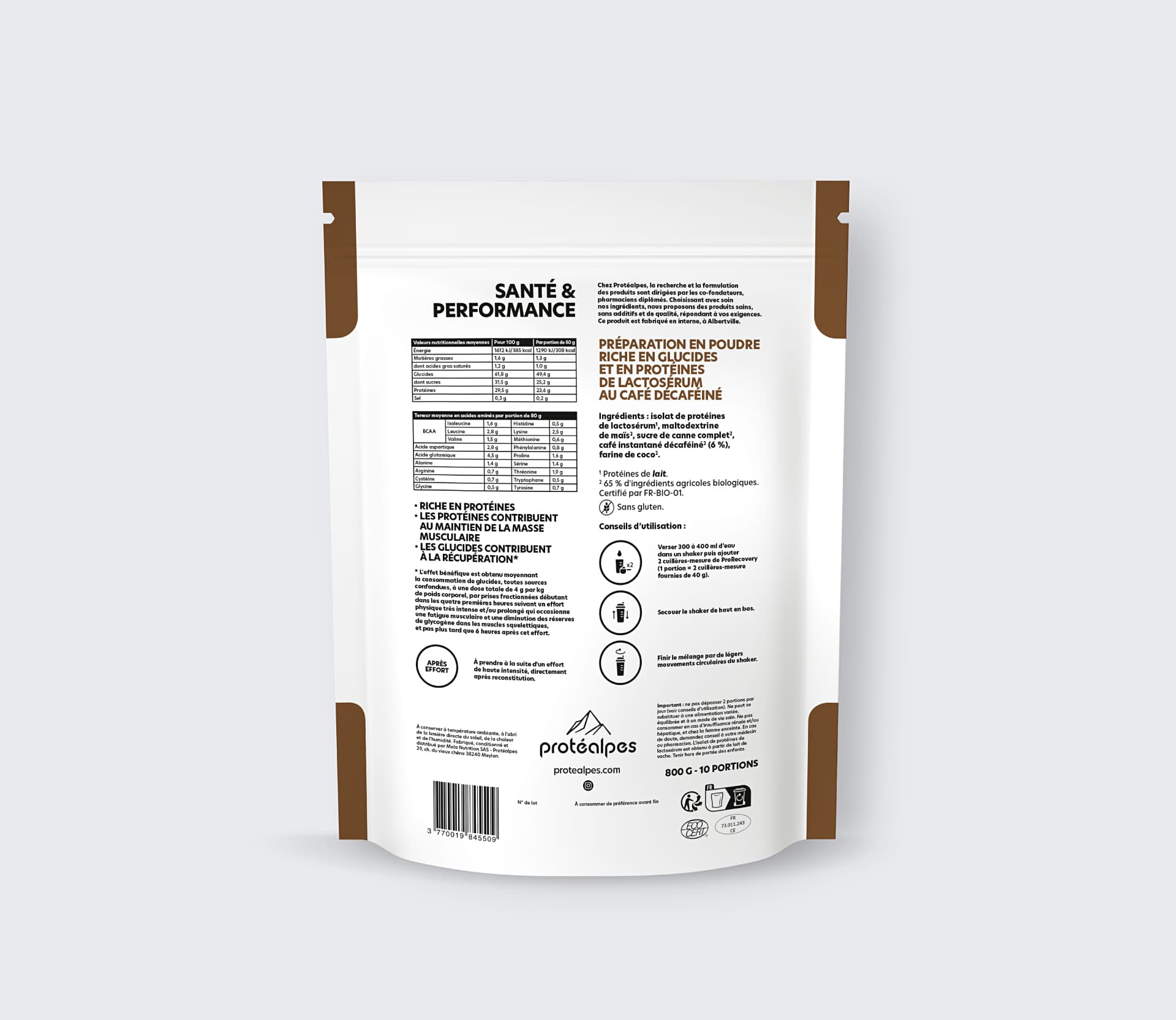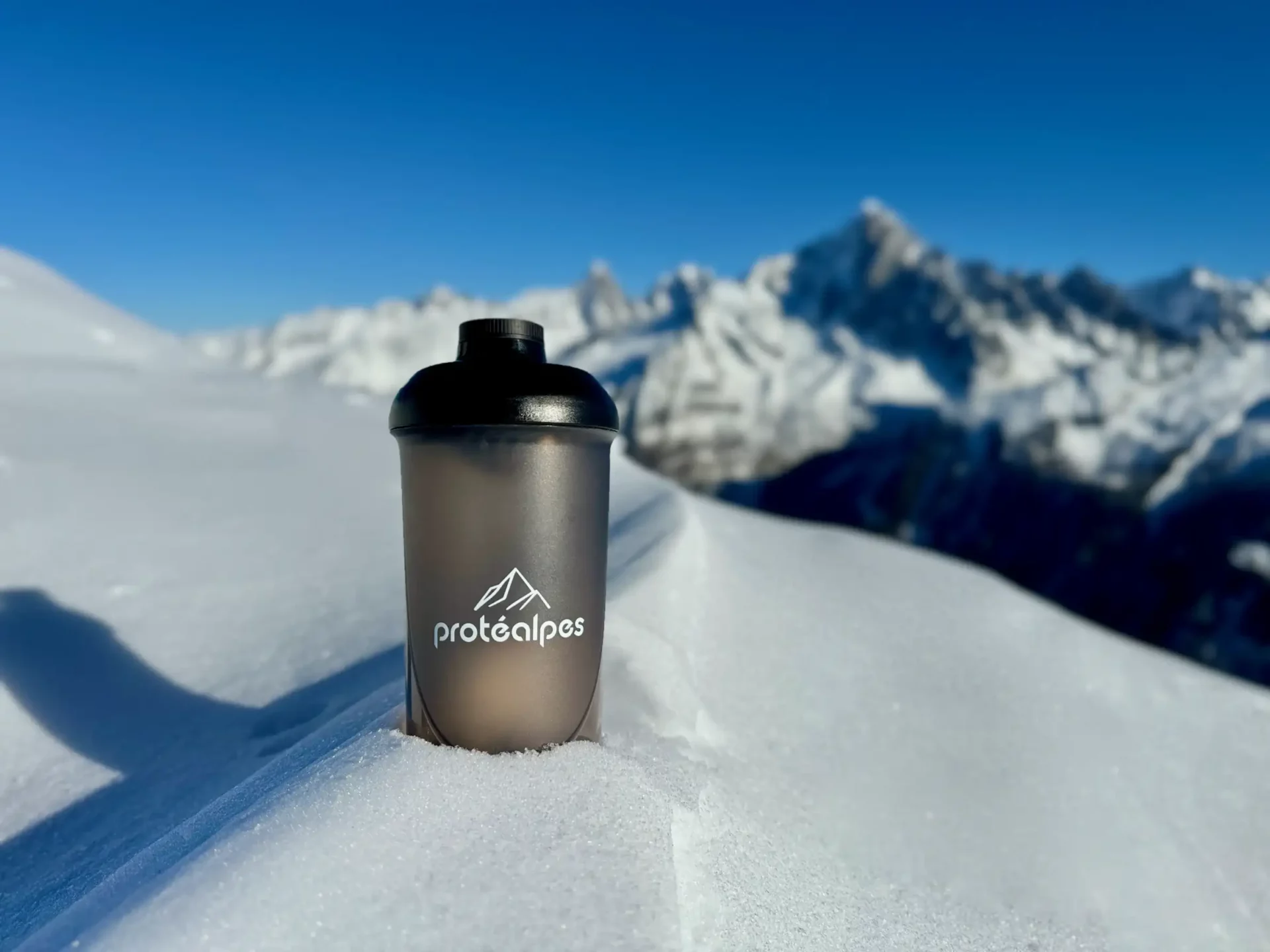


23,6 g
Protein per serving
5.9 g
BCAA per serving
49,4 g
Carbohydrates per serving
| Protein from the milk of Alpine pasture cows | |
| No additives, no sweeteners | |
| Dissolves easily in milk or water, without lumps | |
| Quality amino acids, rich in BCAAs | |
| Ideal for recovery from high-intensity endurance sports | |
| Standard anti-doping products |
In detail
- Protein-rich, additive- and gluten-free, standardized doping substance-free
- Complete muscle recovery (glycogen replenishment, muscle fiber repair, rehydration)
- 2:1 carbohydrate-to-protein ratio, ideal for post-workout high-intensity endurance training
- Protein isolate from Rhône-Alpes pasture milk, produced and packaged by Protéalpes in Albertville.
Ingredients
Powdered preparation, rich in carbohydrates and whey protein
- Whey protein isolate(36%)*, corn maltodextrin**, wholegrain cane sugar**, decaffeinated instant coffee** (6%), coconut flour**.
*Protéines de lait. (Concentration en lactose < 3 %)
**65 % d’ingrédients agricoles biologiques
Certifié par FR-BIO-01
No sweeteners (sucralose, aspartame, acesulfame k, steviol glycosides...)
Gluten-free



Very detailed description
Ingredients
Powdered preparation, rich in carbohydrates and whey protein
- Whey protein isolate(36%)*, corn maltodextrin**, wholegrain cane sugar**, decaffeinated instant coffee** (6%), coconut flour**.
*Protéines de lait. (Concentration en lactose < 3 %)
**65 % d’ingrédients agricoles biologiques
Certifié par FR-BIO-01
No sweeteners (sucralose, aspartame, acesulfame k, steviol glycosides...)
Gluten-free
The best for muscle recovery after high-intensity endurance exercise
After a high-intensity endurance effort (running, post-match, specific training with glycogen depletion), it is recommended to increase the carbohydrate ratio in recovery nutrition.
A 2:1 intake (carbohydrates:protein), based on a standard dose of 23 g of protein, represents in this case an ideal post-exertion intake.
- Improving aerobic performance
- Muscle recovery, optimizing the beneficial effects of exercise
- Reduce body fat to lean mass ratio, control weight
Respect for the environment, animals and people

- Low concentration of animals in Rhône-Alpes pastures (up to 2,500 m)
- Small-scale farms in the French Alps
- Traditional breeds with low yields (Tarines, Abondances), adapted to mountain environments
- Traditional grass and hay diet from the geographical area, GMO-free
- Coherence and sustainable development of the agricultural system with its environment and time.
What's the difference with other products on the market?
We deal directly with a union of dairy producers (Union des Producteurs de Beaufort), which means we don't go through intermediaries, wholesalers or milk giants. This unique proximity to local primary producers ensures total traceability.
We carefully manufacture our nutrition products in Albertville, in the heart of the Alps. The fact that we use no subcontractors and keep and control all stages of production in-house means that we can control the quality of our nutrition products, and in particular that we are certified to NF EN 17444 (formerly NF V94-001), a European anti-doping sports standard.
This standard certifies the absence of doping contaminants in our products, bearing in mind that on average, 15% of dietary supplements on the market contain doping substances such as anabolic steroids (1).
(1) Int J Sport Med. - 2004 - Geyer et al - Analysis of non-hormonal nutritional supplements for anabolic-androgenic steroids - results of an international study - Professional

Average nutritional values
Average nutritional values | Per 100 g | Per 80 g serving |
Energy | 1616 kJ/386 kcal | 1290 kJ/308 kcal |
Fats and oils | 1,8 g | 1,5 g |
of which saturated fatty acids | 1,4 g | 1,2 g |
Carbohydrates | 62,0 g | 49,6 g |
of which sugars | 32,3 g | 25,8 g |
Protein (Nx6.25 on wet matter) - Regulation (EU) 1169/2011 | 29,6 g | 23,7 g |
Protein (Nx6.38 on dry matter) - Indicative | 31,1 g | 24,9 g |
Salt | 0,3 g | 0,2 g |
Average amino acid content
Average amino acid content per 80g serving | ||||
BCAA | Isoleucine | 1,6 g | Histidine | 0,5 g |
Leucine | 2,8 g | Lysine | 2,5 g | |
Valine | 1,5 g | Methionine | 0,6 g | |
Aspartic acid | 2,8 g | Phenylalanine | 0,8 g | |
Glutamic acid | 4,5 g | Proline | 1,6 g | |
Alanine | 1,4 g | Serine | 1,4 g | |
Arginine | 0,7 g | Threonine | 1,9 g | |
Cysteine | 0,7 g | Tryptophan | 0,5 g | |
Glycine | 0,5 g | Tyrosine | 0,7 g | |
Terms of use
- Pour 400 ml of liquid into a shaker, then add 2 scoops of Pro Recovery (1 portion = 2 scoops (40g)).
- Mix with a shaker. Shake from bottom to top 3 to 4 times maximum.
- Finish with light circular movements of the shaker
Ideally, consume between 30 minutes and 3 hours after exercise. Avoid consuming just before a meal, as the appetite-suppressant effect may reduce the amount consumed during the traditional meal.
Certificates & labels
- Certificate of origin Whey protein Protéalpes (PDF)
- Protéalpes manufacturing certificate (PDF)
- Protéalpes packaging certificate (PDF)
- Pro Recovery vanilla label 800g Protéalpes
- Pro Recovery cocoa label 800g Protéalpes
- Pro Recovery decaffeinated coffee label 800g Protéalpes
- Pro Recovery label caramel taste 800g Protéalpes
- Strawberry flavor Pro Recovery label 800g Protéalpes
Discover also
Brand reviews
Frequently asked questions
What's the difference between Pro Recovery and Altitude Whey Protein?
We standardize all our recovery products on a basis of around 23 g of protein per intake. So there's no major difference in protein intake between these two products. The difference lies in carbohydrates. Whey is a solution for recovery and optimizing the effects of training for daily use. In addition to its 23 g of protein, the classic range contains a minimum of carbohydrates, necessary for optimal metabolic assimilation of proteins at muscle fiber level and for slight glycogen depletion. It is therefore suitable for recovery from low- to medium-intensity efforts, or for strength events.
Pro Recovery, on the other hand, supplements this protein intake with a larger quantity of rapidly assimilated carbohydrates (around 50 g). Recovery is optimal for very intense post-exercises, when glycogen depletion is high.
Pro Recovery is therefore best suited to occasional use (post-match, post-run, especially intense post-training sessions...).
What is protein isolate?
Whey protein is derived from whey, a fraction of cow's milk. Our whey is a mechanically filtered isolate (microfiltration/ultrafiltration), cold filtered so as not to denature the proteins, then dried (drying time on the order of ms) by an atomization process, to obtain a very small-diameter powder.
Whey proteins are mainly represented by beta lactoglobulin, alpha lactalbumin, bovine serum albumin, lactoferrin and immunoglobulins.
These proteins are made up of amino acids, and are particularly rich in essential amino acids and BCAAs (Leucine, Isoleucine, Valine), which play a vital role in muscle building. This is why these products have begun to be used in bodybuilding. Whey proteins also contain significant quantities of glutamate (precursor of glutamine) and arginine.
Why aren't these products certified organic?
We use as many organic ingredients as possible (sugar, vanilla powder, cocoa, corn maltodextrin, etc.), and in this respect are controlled and certified by Ecocert. However, the milk from which our whey isolate is made is not certified organic. We have chosen to use local milk from Alpine pastures rather than organic milk, which is often collected in large European plants before being redistributed.
When should Pro Recovery be taken?
As we have seen, Pro Recovery is ideal for post-exercise, especially after very intense effort (post-match, post-run, especially intense post-training...).
As the intake is more substantial than for a classic whey (one intake = 80 g of product in 400 ml), the timing of the intake, in relation to a meal in particular, needs to be taken into account.
In fact, if a complete and balanced meal is planned for the post-exercise period and cannot be postponed, then Pro Recovery should not be taken just before this meal, to avoid the appetite-suppressant effect and reduce the intake of this meal.
That said, you can take it before a meal, if you stay away from it long enough (at least 1 h/1.5 h). After this time, the appetite-suppressant effect should be very limited.
Finally, it can also be taken as a dessert with a meal, if the latter is necessarily placed just after the physical effort.
NB: we're talking here about a complete, balanced meal. If a medium-quality meal is planned (fast food, pizzas...), then it's better to opt for Pro Recovery, even if it's just before the meal, as this may reduce the latter.
Do you add BCAAs to your products?
We do not add any protein supplements. Most of the amino acids come from our whey powder, which is naturally highly concentrated in BCAAs (Leucine, Isoleucine, Valine), unlike other vegetable protein sources. The rest of the amino acids come from our unprocessed secondary ingredients (cocoa, for example), although this proportion is negligible.
Why does a layer of foam develop after mixing?
Tip to minimize foaming in the shaker: in hot weather, the mixture may foam a lot in the shaker. This is a natural phenomenon. Heat disrupts the molecular arrangement of proteins and water. To prevent this, store your protein sachet in a cool place, such as the cellar, or even the fridge. This will in no way alter the quality of the powder, and will ensure a foam-free mix!
Proteins naturally foam when reconstituted with liquid, depending on their purity. To avoid this, lecithin (generally soy lecithin) is often used by major nutrition brands. Lecithin is an additive, an emulsifier, and we have chosen not to use it. This is why the product may foam a little after vigorous mixing. This foaming is only temporary and perfectly normal. To obtain a perfect blend, place the liquid in the shaker first, then the powder. Finally, mix as described on the back of the pack.
We do not wish to use processed products derived from soy. Soy crops are very often GMO, and the isolation of lecithin involves undesirable solvents.

















